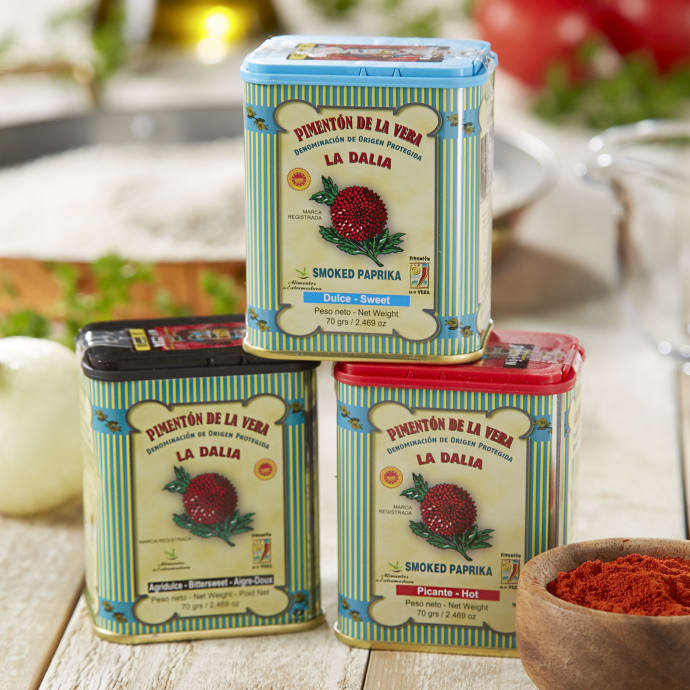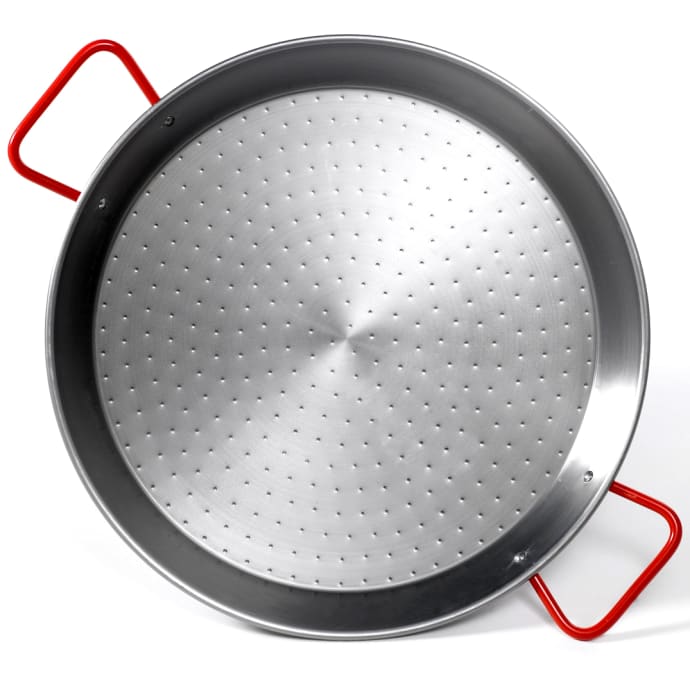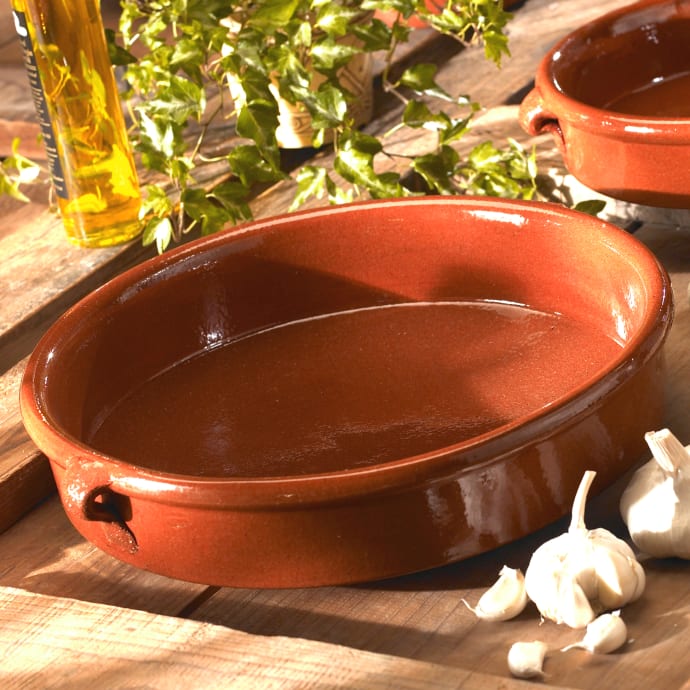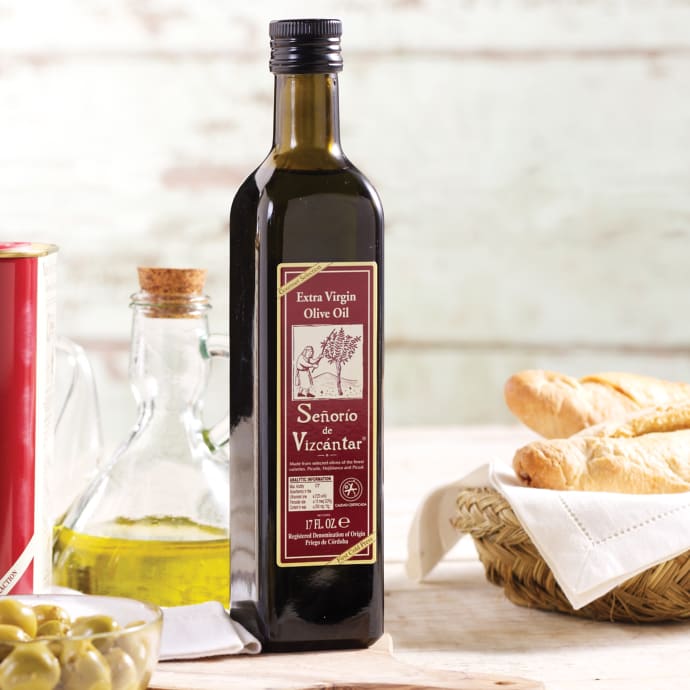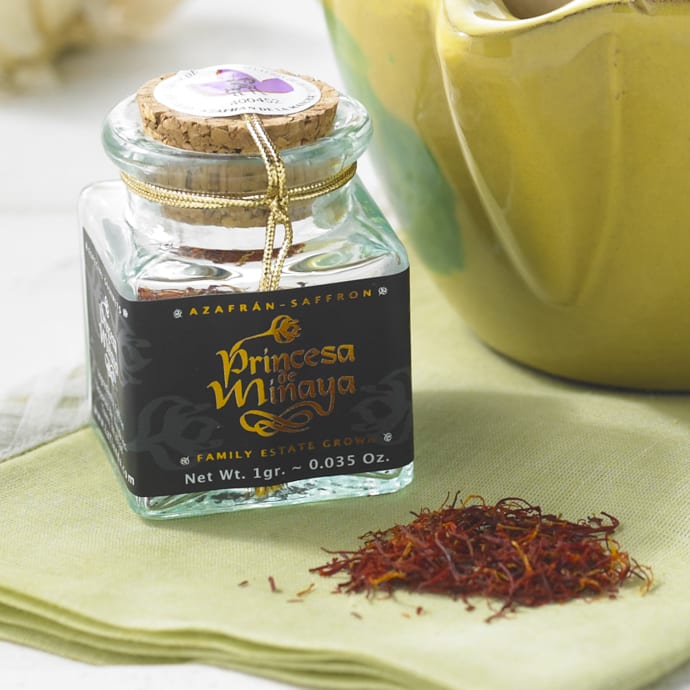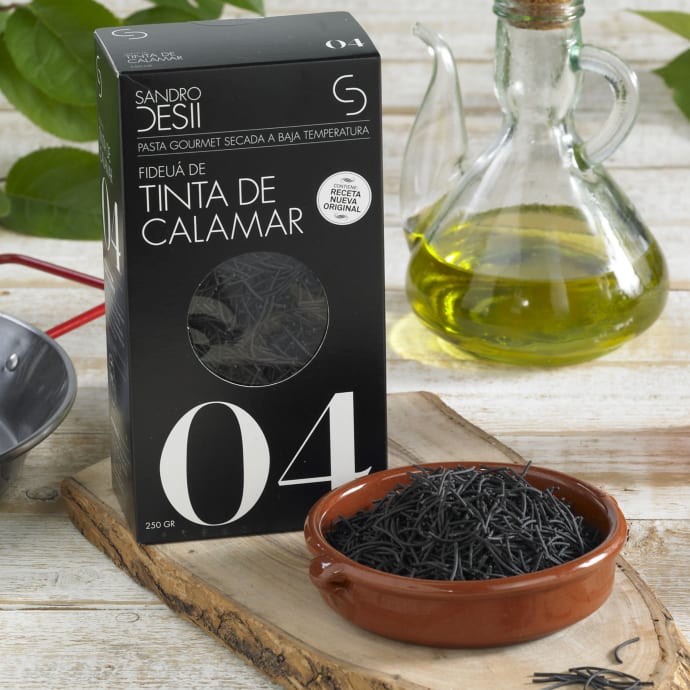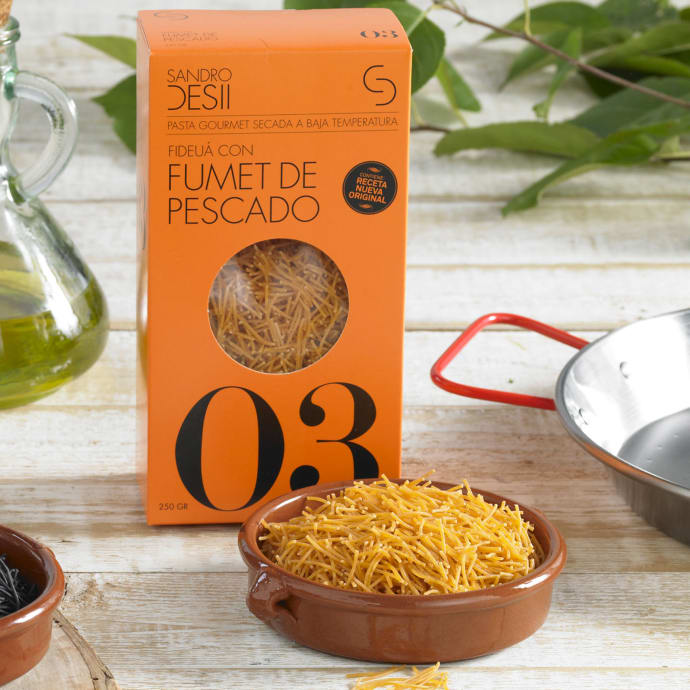
The Spanish Word on Pasta
The Chicago Tribune
-
December 19, 2007
Fideos deliver fresh approach to the world of pasta
Janet Mendel
If you think pasta belongs only to the Italians and noodles to the Asians, think again. In Spain, pasta talks Spanish and the word is fideos (fee-DAY-ohs). Fideos (fideus in Catalan) are thin, round noodles, the sort you might put in chicken-noodle soup. They range in thickness from threads of angel hair to spaghetti-like cords. Fideos go into soups, casseroles and -- surprise -- even paella.
Spanish fideo noodles, like many pastas, are made of durum wheat and water, rolled, cut and dried. But they are prepared quite differently than Italian-style pasta. For one thing, sometimes the dry pasta is first toasted in olive oil. Next, instead of being cooked in a pot of boiling water, then being sauced, the fideos cook right in the sauce, soaking up the flavors. And "al dente" is not a Spanish approach! Fideos are cooked until completely tender and toothsome.
Fideos are packaged coiled into nests (in which case you break them into short lengths before cooking) or else conveniently cut into 1-inch pieces. They are milled in thicknesses from 0 (less than 1/16 inch) to 4 (slightly less than 1/8 inch). The thinnest ones, the same as capellini or angel's hair, are used in soups. The thicker ones, for which spaghetti is a good substitute, are for casseroles or paella. There also is a 1/2-inch elbow fideo with a pinhole through it. It's thicker than a 4 fideo, but cooks in the same time because it's hollow.
In the beginning there were fideos -- simple, hand-rolled cords of dough cooked in liquid -- which may have been invented by the Greeks or the Persians or the Arabs, according to Alan Davidson's "Oxford Companion to Food." Probably both Spain and Italy received their pasta legacy from the Arabs, who invaded parts of both countries between the 8th and 9th Centuries. In the ensuing centuries Italians put more twists on the simple flour and water paste, while Spaniards kept the purity of the fideo. Fideos have come down to modern times also in Sephardic Jewish cookery, which includes recipes for fidellos.
Spain's classic fideo dish is cazuela, a casserole cooked in a flameproof earthenware pot, also called a cazuela. The casserole can include seafood or pork and sausages. The noodles are served in the pot.
But, how did pasta get into paella? The word "paella" refers to the pan: a wide, shallow, two-handled frying pan in which the famous rice dish is cooked.
The story goes that a bunch of friends set off for the beach to make a festive outdoor paella. Someone forgot the rice, so they improvised with noodles. Well, maybe. Or maybe it happened the other way around: A busy housewife starts out to make a typical cazuela de fideos, pasta cooked in an earthenware casserole. When she accidentally cracks the crock, she reaches for a paella pan to replace the cazuela.
In cooking fideos it's a good idea to add the liquid in two or three stages. The finished noodles should be juicy with sauce, but never soupy.
- - -
Where to buy fideos
We found fideos and other Spanish ingredients online at the specialty-foods site La Tienda, tienda.com. A three-pack is $10.
Fish with pasta paella
Preparation time: 35 minutes
Cooking time: 48 minutes
Yield: 8 servings
Use a solid-fleshed fish such as monkfish, grouper, snapper or rockfish. The unpeeled shrimp serve as an attractive garnish on top of the dish.
6 tablespoons olive oil
1/2 green bell pepper, seeded, chopped
3 cloves garlic, chopped
1 tablespoon Spanish sweet or smoked paprika
2 teaspoons salt
4 tomatoes, cored, diced or 1 can (28 ounces) diced tomatoes, drained
1 small squid (10 ounces), cleaned, cut into small pieces
3 cans (14 ounces each) chicken broth
2 bottles (8 ounces each) clam juice
6 halibut or other white fish fillets, about 6 ounces each
1/2 pound large unpeeled shrimp, plus 1/4 pound peeled deveined shrimp
1 pound fideos or spaghetti, broken into short lengths
1/4 teaspoon saffron threads, crushed to a powder
1/4 teaspoon ground cumin
Freshly ground pepper
Garlic mayonnaise, see recipe
1. Heat the 3 tablespoons of the oil in a Dutch oven over medium-high heat; add green pepper and garlic. Cook, stirring, until softened, about 5 minutes. Stir in the paprika and salt; cook 30 seconds. Stir in the tomatoes, squid, broth and clam juice. Heat to a boil; lower heat to a simmer. Cook 20 minutes.
2. Raise heat to high; heat to a boil. Add the fish. Lower heat to a simmer; cook until the fish begins to flake when probed with a fork, about 5-10 minutes, depending on its thickness. Remove the fish gently; transfer to a plate. Keep the broth warm in the Dutch oven.
3. Heat remaining 3 tablespoons of the oil in a large skillet or paella pan. Add the unpeeled shrimp; cook, turning occasionally, until shrimp is pink and translucent, about 4 minutes. Transfer to a plate; set aside.
4. Add the pasta to the skillet; cook, stirring and tossing, until lightly golden, about 3 minutes. Add all but 1/2 cup of the reserved hot broth to the pan; heat to a boil. Meanwhile, stir the saffron, cumin and pepper to taste into the 1/2 cup of broth in a small bowl; stir mixture into the pasta. Cook until the pasta softens, about 5 minutes.
5. Stir in the peeled shrimp; cook just until shrimp turns pink and is cooked through, about 1 minute. Arrange the reserved fish and shrimp on top of the pasta. Cook until pasta is tender, about 2 minutes. Turn off the heat; allow the pasta to rest 5 minutes before serving. Serve with the alioli.
Nutrition information per serving:
538 calories, 28% of calories from fat, 17 g fat, 3 g saturated fat, 228 mg cholesterol, 48 g carbohydrates, 48 g protein, 1,250 mg sodium, 4 g fiber
Garlic mayonnaise (Alioli)
Preparation time: 5 minutes
Yield: 1 cup
This quick version of alioli, garlic mayonnaise, does not use raw eggs.
1/2 cup prepared mayonnaise
4 cloves garlic, crushed
1/2 cup extra-virgin olive oil
1 tablespoon lemon juice
1/2 teaspoon salt or more to taste
Freshly ground pepper
Whisk the mayonnaise in a small bowl until light and smooth; add the crushed garlic. Slowly whisk in the olive oil until smooth; stir in the lemon juice, salt and pepper to taste. Taste for seasoning; add additional salt if needed.
Nutrition information per tablespoon:
111 calories, 99% of calories from fat, 12 g fat, 2 g saturated fat, 2.5 mg cholesterol, 0.3 g carbohydrates, 0 g protein, 110 mg sodium, 0 g fiber
Pork chop
Preparation time: 25 minutes
Cooking time: 50 minutes
Resting time: 5 minutes
Yield: 4 servings
Meaty spare ribs or country ribs, cut into pieces, may be used in place of the pork chops. Spanish smoked paprika is sold in specialty markets and some larger supermarkets and on ethnic-food Web sites including tienda.com.
4 medium rib pork chops
1 teaspoon salt
Freshly ground black pepper
3 tablespoons olive oil
2 onions, chopped
1 green bell pepper, ribbed, seeded, cut into 1-inch pieces
3 cloves garlic, chopped
2 tomatoes, peeled, seeded, chopped
1/2 teaspoon red pepper flakes
5 cups plus 2 tablespoons water
2 teaspoons Spanish smoked paprika
2 bay leaves
1 cup frozen or fresh shelled peas
1/2 teaspoon dried thyme, crumbled
3/4 pound thick fideos or spaghetti, broken into short lengths
1. Season the pork chops with 1/2 teaspoon of the salt and black pepper to taste. Heat the oil in a large skillet or Dutch oven over medium-high heat; add the chops. Cook, turning once, until brown on both sides, about 3 minutes per side; transfer chops to a plate. Add the onions and bell pepper to the skillet; cook, stirring, until onions begin to soften, about 3 minutes. Add the garlic; cook, stirring, 1 minute. Add the tomatoes and red pepper flakes; lower heat to medium. Cook, stirring occasionally, until mixture thickens, about 15 minutes.
2. Mix 2 tablespoons of the water and the paprika in a small bowl; stir until smooth. Add the paprika mixture to the skillet with the remaining 5 cups of the water. Add the bay leaves, peas, thyme and remaining 1/2 teaspoon of the salt; heat to a boil over medium-high heat.
3. Return the pork chops to the skillet. Stir in the pasta. Cook, without stirring, 5 minutes. Lower the heat to medium-low; cook without stirring, 10 minutes. Stir; cover. Cook, stirring occasionally, until mixture is "juicy" but not soupy and the pasta is tender, about 10 minutes. Let stand 5-10 minutes before serving.
Nutrition information per serving:
577 calories, 27% of calories from fat, 18 g fat, 4 g saturated fat, 31 mg cholesterol, 80 g carbohydrates, 25 g protein, 660 mg sodium, 9 g fiber
Janet Mendel
If you think pasta belongs only to the Italians and noodles to the Asians, think again. In Spain, pasta talks Spanish and the word is fideos (fee-DAY-ohs). Fideos (fideus in Catalan) are thin, round noodles, the sort you might put in chicken-noodle soup. They range in thickness from threads of angel hair to spaghetti-like cords. Fideos go into soups, casseroles and -- surprise -- even paella.
Spanish fideo noodles, like many pastas, are made of durum wheat and water, rolled, cut and dried. But they are prepared quite differently than Italian-style pasta. For one thing, sometimes the dry pasta is first toasted in olive oil. Next, instead of being cooked in a pot of boiling water, then being sauced, the fideos cook right in the sauce, soaking up the flavors. And "al dente" is not a Spanish approach! Fideos are cooked until completely tender and toothsome.
Fideos are packaged coiled into nests (in which case you break them into short lengths before cooking) or else conveniently cut into 1-inch pieces. They are milled in thicknesses from 0 (less than 1/16 inch) to 4 (slightly less than 1/8 inch). The thinnest ones, the same as capellini or angel's hair, are used in soups. The thicker ones, for which spaghetti is a good substitute, are for casseroles or paella. There also is a 1/2-inch elbow fideo with a pinhole through it. It's thicker than a 4 fideo, but cooks in the same time because it's hollow.
In the beginning there were fideos -- simple, hand-rolled cords of dough cooked in liquid -- which may have been invented by the Greeks or the Persians or the Arabs, according to Alan Davidson's "Oxford Companion to Food." Probably both Spain and Italy received their pasta legacy from the Arabs, who invaded parts of both countries between the 8th and 9th Centuries. In the ensuing centuries Italians put more twists on the simple flour and water paste, while Spaniards kept the purity of the fideo. Fideos have come down to modern times also in Sephardic Jewish cookery, which includes recipes for fidellos.
Spain's classic fideo dish is cazuela, a casserole cooked in a flameproof earthenware pot, also called a cazuela. The casserole can include seafood or pork and sausages. The noodles are served in the pot.
But, how did pasta get into paella? The word "paella" refers to the pan: a wide, shallow, two-handled frying pan in which the famous rice dish is cooked.
The story goes that a bunch of friends set off for the beach to make a festive outdoor paella. Someone forgot the rice, so they improvised with noodles. Well, maybe. Or maybe it happened the other way around: A busy housewife starts out to make a typical cazuela de fideos, pasta cooked in an earthenware casserole. When she accidentally cracks the crock, she reaches for a paella pan to replace the cazuela.
In cooking fideos it's a good idea to add the liquid in two or three stages. The finished noodles should be juicy with sauce, but never soupy.
- - -
Where to buy fideos
We found fideos and other Spanish ingredients online at the specialty-foods site La Tienda, tienda.com. A three-pack is $10.
Fish with pasta paella
Preparation time: 35 minutes
Cooking time: 48 minutes
Yield: 8 servings
Use a solid-fleshed fish such as monkfish, grouper, snapper or rockfish. The unpeeled shrimp serve as an attractive garnish on top of the dish.
6 tablespoons olive oil
1/2 green bell pepper, seeded, chopped
3 cloves garlic, chopped
1 tablespoon Spanish sweet or smoked paprika
2 teaspoons salt
4 tomatoes, cored, diced or 1 can (28 ounces) diced tomatoes, drained
1 small squid (10 ounces), cleaned, cut into small pieces
3 cans (14 ounces each) chicken broth
2 bottles (8 ounces each) clam juice
6 halibut or other white fish fillets, about 6 ounces each
1/2 pound large unpeeled shrimp, plus 1/4 pound peeled deveined shrimp
1 pound fideos or spaghetti, broken into short lengths
1/4 teaspoon saffron threads, crushed to a powder
1/4 teaspoon ground cumin
Freshly ground pepper
Garlic mayonnaise, see recipe
1. Heat the 3 tablespoons of the oil in a Dutch oven over medium-high heat; add green pepper and garlic. Cook, stirring, until softened, about 5 minutes. Stir in the paprika and salt; cook 30 seconds. Stir in the tomatoes, squid, broth and clam juice. Heat to a boil; lower heat to a simmer. Cook 20 minutes.
2. Raise heat to high; heat to a boil. Add the fish. Lower heat to a simmer; cook until the fish begins to flake when probed with a fork, about 5-10 minutes, depending on its thickness. Remove the fish gently; transfer to a plate. Keep the broth warm in the Dutch oven.
3. Heat remaining 3 tablespoons of the oil in a large skillet or paella pan. Add the unpeeled shrimp; cook, turning occasionally, until shrimp is pink and translucent, about 4 minutes. Transfer to a plate; set aside.
4. Add the pasta to the skillet; cook, stirring and tossing, until lightly golden, about 3 minutes. Add all but 1/2 cup of the reserved hot broth to the pan; heat to a boil. Meanwhile, stir the saffron, cumin and pepper to taste into the 1/2 cup of broth in a small bowl; stir mixture into the pasta. Cook until the pasta softens, about 5 minutes.
5. Stir in the peeled shrimp; cook just until shrimp turns pink and is cooked through, about 1 minute. Arrange the reserved fish and shrimp on top of the pasta. Cook until pasta is tender, about 2 minutes. Turn off the heat; allow the pasta to rest 5 minutes before serving. Serve with the alioli.
Nutrition information per serving:
538 calories, 28% of calories from fat, 17 g fat, 3 g saturated fat, 228 mg cholesterol, 48 g carbohydrates, 48 g protein, 1,250 mg sodium, 4 g fiber
Garlic mayonnaise (Alioli)
Preparation time: 5 minutes
Yield: 1 cup
This quick version of alioli, garlic mayonnaise, does not use raw eggs.
1/2 cup prepared mayonnaise
4 cloves garlic, crushed
1/2 cup extra-virgin olive oil
1 tablespoon lemon juice
1/2 teaspoon salt or more to taste
Freshly ground pepper
Whisk the mayonnaise in a small bowl until light and smooth; add the crushed garlic. Slowly whisk in the olive oil until smooth; stir in the lemon juice, salt and pepper to taste. Taste for seasoning; add additional salt if needed.
Nutrition information per tablespoon:
111 calories, 99% of calories from fat, 12 g fat, 2 g saturated fat, 2.5 mg cholesterol, 0.3 g carbohydrates, 0 g protein, 110 mg sodium, 0 g fiber
Pork chop
Preparation time: 25 minutes
Cooking time: 50 minutes
Resting time: 5 minutes
Yield: 4 servings
Meaty spare ribs or country ribs, cut into pieces, may be used in place of the pork chops. Spanish smoked paprika is sold in specialty markets and some larger supermarkets and on ethnic-food Web sites including tienda.com.
4 medium rib pork chops
1 teaspoon salt
Freshly ground black pepper
3 tablespoons olive oil
2 onions, chopped
1 green bell pepper, ribbed, seeded, cut into 1-inch pieces
3 cloves garlic, chopped
2 tomatoes, peeled, seeded, chopped
1/2 teaspoon red pepper flakes
5 cups plus 2 tablespoons water
2 teaspoons Spanish smoked paprika
2 bay leaves
1 cup frozen or fresh shelled peas
1/2 teaspoon dried thyme, crumbled
3/4 pound thick fideos or spaghetti, broken into short lengths
1. Season the pork chops with 1/2 teaspoon of the salt and black pepper to taste. Heat the oil in a large skillet or Dutch oven over medium-high heat; add the chops. Cook, turning once, until brown on both sides, about 3 minutes per side; transfer chops to a plate. Add the onions and bell pepper to the skillet; cook, stirring, until onions begin to soften, about 3 minutes. Add the garlic; cook, stirring, 1 minute. Add the tomatoes and red pepper flakes; lower heat to medium. Cook, stirring occasionally, until mixture thickens, about 15 minutes.
2. Mix 2 tablespoons of the water and the paprika in a small bowl; stir until smooth. Add the paprika mixture to the skillet with the remaining 5 cups of the water. Add the bay leaves, peas, thyme and remaining 1/2 teaspoon of the salt; heat to a boil over medium-high heat.
3. Return the pork chops to the skillet. Stir in the pasta. Cook, without stirring, 5 minutes. Lower the heat to medium-low; cook without stirring, 10 minutes. Stir; cover. Cook, stirring occasionally, until mixture is "juicy" but not soupy and the pasta is tender, about 10 minutes. Let stand 5-10 minutes before serving.
Nutrition information per serving:
577 calories, 27% of calories from fat, 18 g fat, 4 g saturated fat, 31 mg cholesterol, 80 g carbohydrates, 25 g protein, 660 mg sodium, 9 g fiber
Other Press
The Winter Travel Shortlist: Problem-Solving Essentials I’m Packing This Season
Forbes
-
November 20, 2025
54 Gifts for People Who Have Everything
Wirecutter
-
November 6, 2025
What Andrew Zimmern Can’t Live Without
The Strategist
-
June 30, 2025
8 Tasty Ways To Travel The World With Food
Forbes
-
June 17, 2025
Featured Products

Smoked Paprika Trio by La Dalia
PK-12
(54)
$22.00$22.00

17 Inch Traditional Steel Paella Pan - Serves 8
PP-02
(17)
$38.00$38.00

Terra Cotta Cazuela - 12.8 Inches
CA-07
(12)
$59.00$59.00
 BEST SELLER
BEST SELLERSeñorío de Vizcántar Special Selection Extra Virgin Olive Oil
OO-45
(42)
$29.00$29.00

Princesa de Minaya Saffron, D.O. La Mancha
SN-09
(53)
$27.00$27.00

Fideuá de Tinta de Calamar - Black Fideo Pasta
SU-27
$14.00$14.00

Fideuá con Fumet de Pescado - Seafood Fideo Pasta
SU-28
(4)
$14.00$14.00

